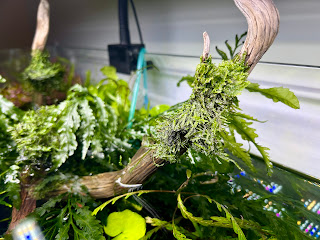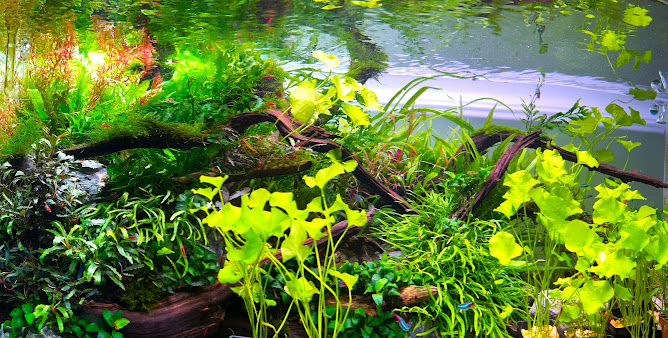Understanding Water Hardness: GH vs. KH & Choosing the Best Water for Your Aquarium
In this article, we will consider water. From pure water to soft and hard tap water, water hardness, and adding minerals to water.
General Hardness (GH): The Mineral Content
What most people refer to as "water hardness" is actually General Hardness (GH). GH measures the concentration of dissolved calcium and magnesium ions in water. These minerals are the primary contributors to what we perceive as "hard" or "soft" water. Higher concentrations of calcium and magnesium mean harder water, while lower concentrations indicate softer water. GH is typically measured in degrees of German hardness (°dH).
Carbonate Hardness (KH): Buffering pH
In contrast to GH, Carbonate Hardness (KH) measures the concentration of carbonate and bicarbonate ions in water. While KH is sometimes called "carbonate hardness," this can be misleading. KH does not directly contribute to the "hardness" in the way GH does (i.e., it doesn't make the water feel harder or softer). Instead, KH is crucial for buffering pH, meaning it helps to keep the water's pH level stable. KH is also measured in °dH.
The Importance of Distinction
Understanding the distinction between GH and KH is key. GH defines the mineral content of the water, while KH controls its pH buffering capacity. Both are important for different reasons.
Degrees of German Hardness (°dH): The Unit of Measurement
It's important to note that °dH (degrees of German hardness) is a unit of measurement, not a type of hardness itself. It's used to express the concentration of both GH and KH. 1 °dH is equivalent to 10 milligrams of calcium oxide (CaO) per litre of water.
General Hardness (GH) - Measured in dGH (degrees of General Hardness)
Very Soft: Less than 4 °dH
Soft: 4 - 8 °dH
Medium Hard: 8 - 12 °dH
Hard: 12 - 18 °dH
Very Hard: More than 18 °dH
Carbonate Hardness (KH) - Measured in dKH (degrees of Carbonate Hardness)
- Very Soft/Low: 0-3°dKH - Can lead to unstable pH
- Soft/Low: 3-6°dKH
- Moderate: 6-12°dKH - Generally suitable for most community tanks
- High: 12+°dKH - Often found in hard water tanks or tanks with African Cichlids
Choosing the Right Water for Your Aquarium
When it comes to aquarium water, we have two starting points: pure water and tap water. Each has its own characteristics and implications for mineralization, the process of adding essential minerals to water in a controlled and precise manner. Mineralization is typically achieved using commercially available mineral powders or liquid supplements specifically formulated with calcium and magnesium minerals, carbonate and bicarbonates, in known ratios.
Both the type and ratio of minerals matter. General Hardness (GH) should include calcium and magnesium in a 3:1 or 4:1 ratio, as calcium supports exoskeleton and bone health, while magnesium aids enzyme function and molting in shrimp. Carbonate Hardness (KH) should be 2–6 °dKH to stabilize pH, though shrimp prefer the lower end for slightly acidic water. Other essential trace minerals include potassium (K⁺) for nerve function and plant growth, iron (Fe) for plant and shrimp health, and small amounts of sodium (Na⁺).
Pure Water
This type of water, known as distilled or reverse osmosis (RO) water, has been stripped of most dissolved minerals and impurities through purification processes. While safe for human consumption when supplemented with essential minerals, it is generally unsuitable for sustaining aquatic ecosystems without re-mineralization.
The benefit of pure water lies in control. Think of it as a blank canvas. Because it starts with virtually nothing, you have absolute control over what you add back in. This allows for precise re-mineralization, giving you the ability to create the exact water parameters you desire.
Tap Water
Tap water is the most readily available water source for aquarists, but unlike pure water, its mineral content varies and is often unknown, but it does contain some minerals. Tap water ranges from 'soft' water with relatively low levels of minerals like calcium and magnesium to 'hard' or 'very hard' water with much higher concentrations.
Testing your tap water to understand where it falls on the mineral hardness scale is crucial, as it determines how you should approach its mineralization for a healthy aquarium environment.
Soft Tap Water: A Good Starting Point
Very soft tap water (less than 4 °dH) and soft tap water (4 - 8 °dH) in general hardness can be a surprisingly advantageous and convenient starting point for many aquarists. In fact, if you discover that your tap water is in the soft range of general hardness (GH), that's a real bonus!
Soft tap water is already low in minerals that contribute to general hardness, so you can easily and precisely add mineral supplements to reach your desired target range.
Using tap water directly is often more convenient and cost-effective than purchasing and handling pure water while still allowing for controlled adjustments.
Even soft tap water contains trace minerals that may be beneficial, although the exact composition is still unknown.
Medium Hard Tap Water: Possibly a Good Option
If your tap water has a GH of 8 - 12 °dH, it may already fall within the desired range, but its exact mineral composition remains uncertain. The Ca: Mg ratio and trace elements play crucial roles in shrimp molting, fish osmoregulation, and plant health. While additional mineralization refines these factors, it also increases hardness.
Even if GH appears ideal, the exact mineral composition matters for long-term aquatic health.
Hard Tap Water: Challenges and Considerations
Tap water that falls into the "hard" category (12-18 °dH) or "very hard" category (above 18 °dH) in general hardness presents more challenges for general freshwater aquariums.
You don't know the specific types and ratios of minerals in your hard tap water, which may not be optimal for all freshwater aquarium inhabitants.
The most common freshwater aquarium fish and plants thrive in soft water (4-8 °dH). Very hard water can be unsuitable for many of these species.
Some fish species, like African cichlids or livebearers (like mollies and guppies), naturally inhabit hard water environments and thrive in harder water. If you are specifically keeping these types of fish, hard tap water may be suitable without extensive modification, although the exact composition is still unknown.
The Best Water for Your Aquarium
There isn't one "best" water for every aquarium, but rather the best water for your specific needs and goals. The most important takeaway is to understand your tap water, understand the needs of your aquarium inhabitants, and make informed decisions about water mineralization. Test both GH and KH to get a complete picture of your water's properties.
Conclusion
By understanding the difference between General Hardness (GH) and Carbonate Hardness (KH) and by recognizing that °dH is simply a unit of measurement, you can make more informed decisions about your water. Whether you're managing an aquarium, adjusting your household water, or simply curious about the water you drink, these concepts are essential for a clear understanding of water chemistry.
Up next: A practical guide to testing GH/KH.
.jpg)

.jpg)